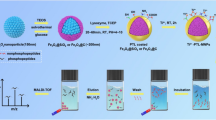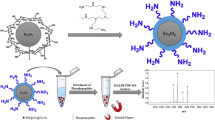Abstract
A novel magnetic nanomaterial for use in metal ion based affinity chromatography is described. It is based on the chelation between the phosphate groups of phytic acid (PA) and Ti(IV) ions. Due to the large number (6) of phosphate groups of PA, it has a large capacity for Ti(IV) ions. PA was first immobilized on magnetite nanoparticles (PA-MNPs) and then loaded with Ti(IV) ions to obtain the sorbent (Ti-PA-MNPs). The fraction of Ti(IV) ions on the surface of PA-MNPs that is exposed to the solution binds the phosphate groups of phosphopeptides. The bound phosphopeptides can then be magnetically separated. The method was applied to the enrichment of the phosphopeptides in a β-casein tryptic digest. A tryptic digest of bovine serum albumin (BSA) was added at a molar ratio (β-casein to BSA) of 1:2000 to study selectivity. The phosphopeptides were quantified by mass spectrometry. The limit of detection can be as low as 8 × 10−10 mol L−1. This sorbent has a high absorption capacity (53.5 μg mg-1) and shows good recoveries (90%). As many as 2145 phosphopeptides were isolated from 500 μg tryptic digest of a rat liver lysate after enrichment by Ti-PA-MNPs. This is superior to that (1568 phosphopeptides) of commercial TiO2 kit.

Schematic presentation of fabrication for a novel modified magnetic nanomaterial (Ti-PA-MNPs) based on the chelation of phytic acid (PA) with Ti(IV) ions. Ti-PA-MNPs were successfully applied to enriching low abundance phosphopeptides from biosamples in mass spectrometric analysis.







Similar content being viewed by others
References
Olsen JV, Blagoev B, Gnad F, Macek B, Kumar C, Mortensen P, Mann M (2006) Global, in vivo, and site-specific phosphorylation dynamics in signaling networks. Cell 127:635–648. https://doi.org/10.1016/j.cell.2006.09.026
Hunter T (2000) Signaling-2000 and Beyond. Cell 100:113–127. https://doi.org/10.1016/S0092-8674(00)81688-8
Cohen P (2000) The regulation of protein function by multisite phosphorylation-a 25 year update. Trends Biochem Sci 25:596–601. https://doi.org/10.1016/S0968-0004(00)01712-6
Zagorac I, Fernandez-GaiteroIn S et al (2018) In vivo phosphoproteomics reveals kinase activity profiles that predict treatment outcome in triple-negative breast cancer. Nat Commun 9(3501):3501. https://doi.org/10.1038/s41467-018-05742-z
Liu F, Iqbal K, Grundke-Iqbal I, Hart GW, Gong CX (2004) O-GlcNAcylation regulates phosphorylation of tau: a mechanism involved in Alzheimer’s disease. Proc Natl Acad Sci U S A 101:10804–10809. https://doi.org/10.1073/pnas.0400348101
Chan CYX, Gritsenko MA, Smith RD, Qian WJ (2016) The current state of the art of quantitative phosphoproteomics and its applications to diabetes research. Expert Rev Proteomic 13:421–433. https://doi.org/10.1586/14789450.2016.1164604
Witze ES, Old WM, Resing KA, Ahn NG (2007) Mapping protein post-translational modifications with mass spectrometry. Nat Methods 4:798–806. https://doi.org/10.1038/nmeth1100
Nita-Lazar A, Saito-Benz H, White FM (2010) Quantitative phosphoproteomics by mass spectrometry: past, present, and future. Proteomics 8:4433–4443. https://doi.org/10.1002/pmic.200800231
Zhang L, Gan YY, Sun HF, Yu BH, Jin XF, Zhang RS, Zhang WB, Zhang LY (2017) Magnetic mesoporous carbon composites incorporating hydrophilic metallic nanoparticles for enrichment of phosphopeptides prior to their determination by MALDI-TOF mass spectrometry. Microchim Acta 184:547–555. https://doi.org/10.1007/s00604-016-2046-6
Piovesana S, Capriotti AL, Cavaliere C, Ferraris F, Iglesias D, Marchesan S, Lagana A (2016) New magnetic graphitized carbon black TiO2 composite for phosphopeptide selective enrichment in shotgun phosphoproteomics. Anal Chem 88:12043–12050. https://doi.org/10.1021/acs.analchem.6b02345
Abelin JG, Trantham PD, Penny SA, Patterson AM, Ward ST, Hildebrand WH, Cobbold M, Bai DL, Shabanowitz J, Hunt DF (2015) Complementary IMAC enrichment methods for HLA-associated phosphopeptide identification by mass spectrometry. Nat Protoc 10:1308–1318. https://doi.org/10.1038/nprot.2015.086
Jiang JB, Sun XN, She XJ, Li JJ, Li Y, Deng CH, Duan GL (2018) Magnetic microspheres modified with Ti(IV) and Nb(V) for enrichment of phosphopeptides. Microchim Acta 185(309):309. https://doi.org/10.1007/s00604-018-2837-z
Zarei M, Sprenger A, Rackiewicz M, Dengjel J (2016) Fast and easy phosphopeptide fractionation by combinatorial ERLIC-SCX solid-phase extraction for in-depth phosphoproteome analysis. Nat Protoc 11:37–45. https://doi.org/10.1038/nprot.2015.134
Zhu GT, He XM, He S, Chen X, Zhu SK, Feng YQ (2016) Synthesis of polyethylenimine functionalized mesoporous silica for in-pipet-tip phosphopeptide enrichment. ACS Appl Mater Interfaces 8:32182–32188. https://doi.org/10.1021/acsami.6b10948
Liu QS, Zhang KN, Jin YH, Xiang XF, Liu Y, Liu HL, Xie MX (2018) Phosphate-imprinted magnetic nanoparticles using phenylphosphonic acid as a template for excellent recognition of tyrosine phosphopeptides. Talanta 186:346–353. https://doi.org/10.1016/j.talanta.2018.04.025
Saeed A, Maya F, Xiao DJ, Najam-ul-Haq M (2014) Growth of a highly porous coordination polymer on a macroporous polymer monolith support for enhanced immobilized metal ion affinity chromatographic enrichment of Phosphopeptides. Adv Funct Mater 24:5790–5797. https://doi.org/10.1002/adfm.201400116
He XM, Chen X, Zhu GT, Wang Q, Yuan BF, Feng YQ (2015) Hydrophilic carboxyl cotton Chelator for titanium(IV) immobilization and its application as novel fibrous sorbent for rapid enrichment of Phosphopeptides. ACS Appl Mater Interfaces 7:17356–17362. https://doi.org/10.1021/acsami.5b04572
Xu XQ, Deng CH, Gao MX, Yu WJ, Yang PY, Zhang XM (2006) Synthesis of magnetic microspheres with immobilized metal ions for enrichment and direct determination of Phosphopeptides by matrix-assisted laser desorption ionization mass spectrometry. Adv Mater 18:3289–3293. https://doi.org/10.1002/adma.200601546
Dunn JD, Igrisan EA, Palumbo AM, Reid GE, Bruening ML (2008) Phosphopeptide enrichment using MALDI plates modified with high-capacity polymer brushes. Anal Chem 80:5727–5735. https://doi.org/10.1021/ac702472j
Wei XN, Shi X (2014) Mesoporous zirconium Phenylphosphonates for selective enrichment of Phosphopeptides. J Phys Chem C 118:4213–4221. https://doi.org/10.1021/jp411346k
Zhou HJ, Ye ML, Dong J, Corradini E, Cristobal A, Heck AJR, Zou HF, Mohammed S (2013) Robust phosphoproteome enrichment using monodisperse microsphere-based immobilized titanium (IV) ion affinity chromatography. Nat Protoc 8:461–480. https://doi.org/10.1038/nprot.2013.010
Zhou HJ, Ye ML, Dong J, Han GH, Jiang XN, Wu RN, Zou HF (2008) Specific phosphopeptide enrichment with immobilized titanium ion affinity chromatography adsorbent for phosphoproteome analysis. J Proteome Res 7:3957–3967. https://doi.org/10.1021/pr800223m
Zhang LY, Zhao Q, Liang Z, Yang KG, Sun LL, Zhang LH, Zhang YK (2012) Synthesis of adenosine functionalized metal immobilized magnetic nanoparticles for highly selective and sensitive enrichment of phosphopeptides. Chem Commun 48:6274–6276. https://doi.org/10.1039/c2cc31641b
Zhang LY, Liang Z, Zhang LH, Zhang YK, Shao SJ (2015) Facile synthesis of gallium ions immobilized and adenosine functionalized magnetic nanoparticles with high selectivity for multi-phosphopeptides. Anal Chim Acta 900:46–55. https://doi.org/10.1016/j.aca.2015.10.012
Su J, He XW, Chen LX, Zhang YK (2018) Adenosine phosphate functionalized magnetic mesoporous graphene oxide nanocomposite for highly selective enrichment of phosphopeptides. ACS Sustain Chem Eng 6:2188–2196. https://doi.org/10.1021/acssuschemeng.7b03607
Zhou CL, Chen ZD, Yang H, Hou K, Zeng XJ, Zheng YF, Cheng J (2017) Nature-inspired strategy toward superhydrophobic fabrics for versatile oil/water separation. ACS Appl Mater Interfaces 9:9184–9194. https://doi.org/10.1021/acsami.7b00412
Cai K, Shen W, Ren BY, He J, Wu SZ, Wang W (2017) A phytic acid modified CoFe2O4 magnetic adsorbent with controllable morphology, excellent selective adsorption for dyes and ultra-strong adsorption ability for metal ions. Chem Eng J 330:936–946. https://doi.org/10.1016/j.cej.2017.08.009
Hong YY, Zhao HL, Pu CL, Zhan QL, Sheng QY, Lan MB (2018) Hydrophilic Phytic acid-coated magnetic graphene for titanium(IV) immobilization as a novel hydrophilic interaction liquid chromatography-immobilized metal affinity chromatography platform for Glyco- and Phosphopeptide enrichment with controllable selectivity. Anal Chem 90:11008–11015. https://doi.org/10.1021/acs.analchem.8b02614
Song XH, Chen YY, Rong MC, Xie ZX, Zhao TT, Wang YR, Chen X, Wolfbeis OS (2016) A Phytic acid induced super-amphiphilic multifunctional 3D graphene-based foam. Angew Chem Int Ed 55:3936–3941. https://doi.org/10.1002/anie.201511064
Hu P, Chang T, Chen WJ, Deng J, Li SL, Zuo YG, Kang L, Fan Y, Hostetter M, Volinsky AA (2019) Temperature effects on magnetic properties of Fe3O4 nanoparticles synthesized by the sol-gel explosion-assisted method. J Alloy Compd 773:605–611. https://doi.org/10.1016/j.jallcom.2018.09.238
Córdoba A, Hierro-Oliva M, Pacha-Olivenza MÁ, FernÁndez-Calderón MC, Perelló J, Isern B, GonzÁlez-Martín ML (2016) Marta Monjo, and Joana M. Ramis direct covalent grafting of Phytate to titanium surfaces through Ti-O-P bonding shows bone stimulating surface properties and decreased bacterial adhesion. ACS Appl Mater Interfaces 8:11326–11335. https://doi.org/10.1021/acsami.6b02533
Nan HY, Liu HC, Li WP, Zhu LQ, Zhang J, Du F (2017) Environmental friendly Phytic acid inhibiter used in sintered NdFeB to prevent corrosion. Surface Technology 46:7–11
Ao YH, Bao JQ, Wang PF, Wang C (2017) J ALLOY COMPD a novel heterostructured plasmonic photocatalyst with high photocatalytic activity: ag@AgCl nanoparticles modified titanium phosphate nanoplates. J Alloy Compd 698:410–419. https://doi.org/10.1016/j.jallcom.2016.12.231
Zhen DS, Gao C, Zhu BD, Zhou Q, Li CY, Chen P, Cai QY (2018) Preparation of Bi0.15Fe0.15TiO2 nanocomposites for the highly selective enrichment of Phosphopeptides. Anal Chem 90:12414–12421. https://doi.org/10.1021/acs.analchem.8b00606
Yang XQ, Xia Y (2016) Urea-modified metal-organic framework of type MIL-101(Cr) for the preconcentration of phosphorylated peptides. Microchim Acta 183:2235–2240. https://doi.org/10.1007/s00604-016-1860-1
Tan SY, Wang JD, Han Q, Liang QL, Ding MY (2018) A porous graphene sorbent coated with titanium (IV)-functionalized polydopamine for selective lab-in-syringe extraction of phosphoproteins and phosphopeptides. Microchim Acta 185(316):316. https://doi.org/10.1007/s00604-018-2846-y
Bae SE, Kim JI, Choi I, Sung J, Hong JI, Yeo WS (2017) Zinc ion-immobilized magnetic microspheres for enrichment and identification of multi-phosphorylated peptides by mass spectrometry. Anal Sci 33:381–1386. https://doi.org/10.2116/analsci.33.1381
Author information
Authors and Affiliations
Corresponding author
Ethics declarations
The authors declare that they have no competing interests. All applicable international, national, and/or institutional guidelines for the care and use of animals were followed.
Additional information
Publisher’s Note
Springer Nature remains neutral with regard to jurisdictional claims in published maps and institutional affiliations.
Electronic supplementary material
ESM 1
(DOCX 15 mb)
Rights and permissions
About this article
Cite this article
Zhang, K., Hu, D., Deng, S. et al. Phytic acid functionalized Fe3O4 nanoparticles loaded with Ti(IV) ions for phosphopeptide enrichment in mass spectrometric analysis. Microchim Acta 186, 68 (2019). https://doi.org/10.1007/s00604-018-3177-8
Received:
Accepted:
Published:
DOI: https://doi.org/10.1007/s00604-018-3177-8




